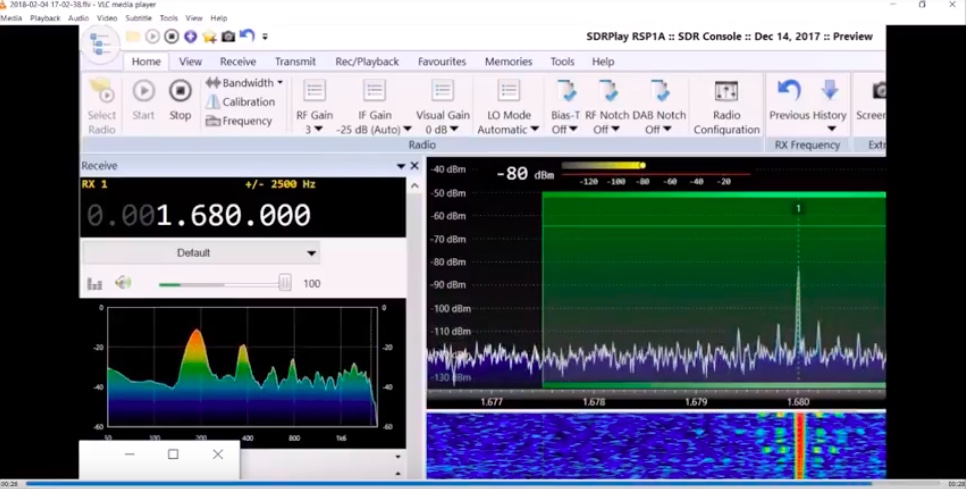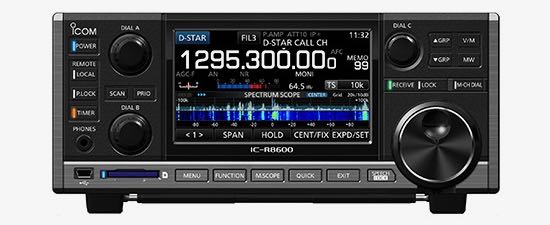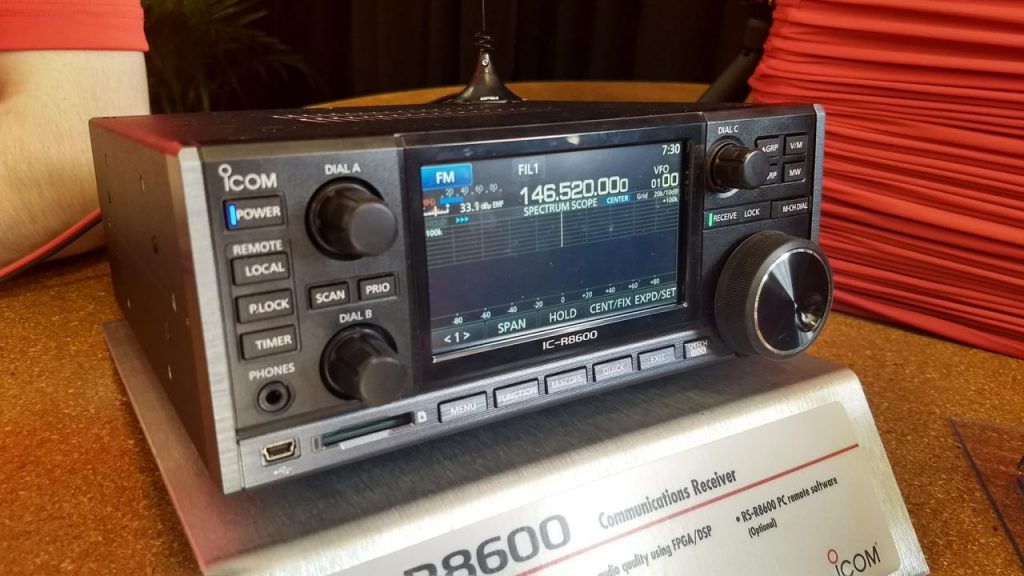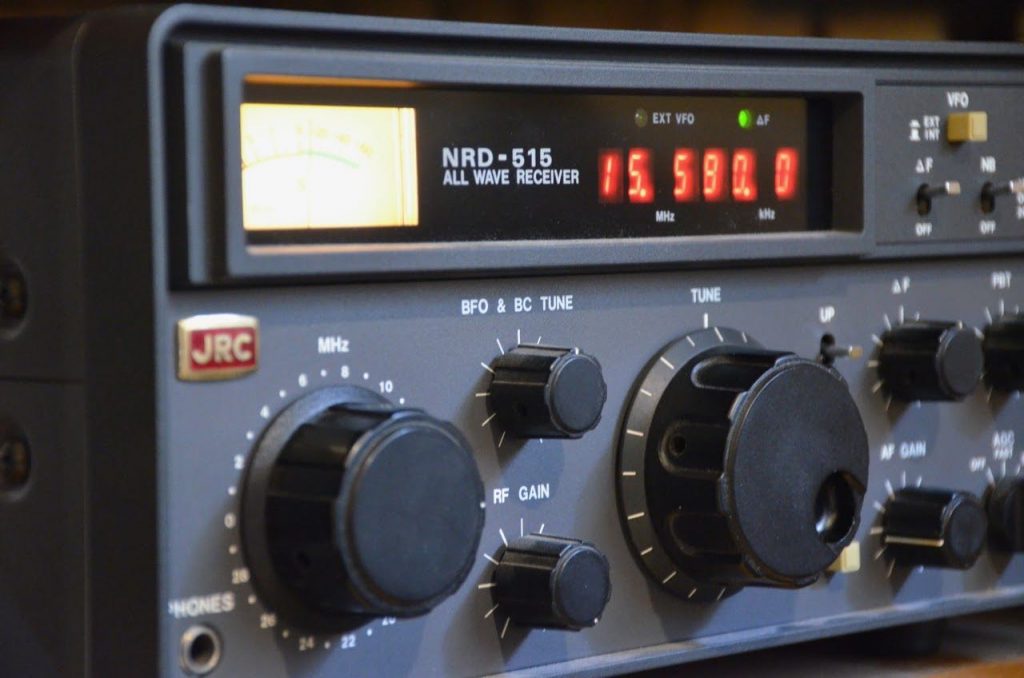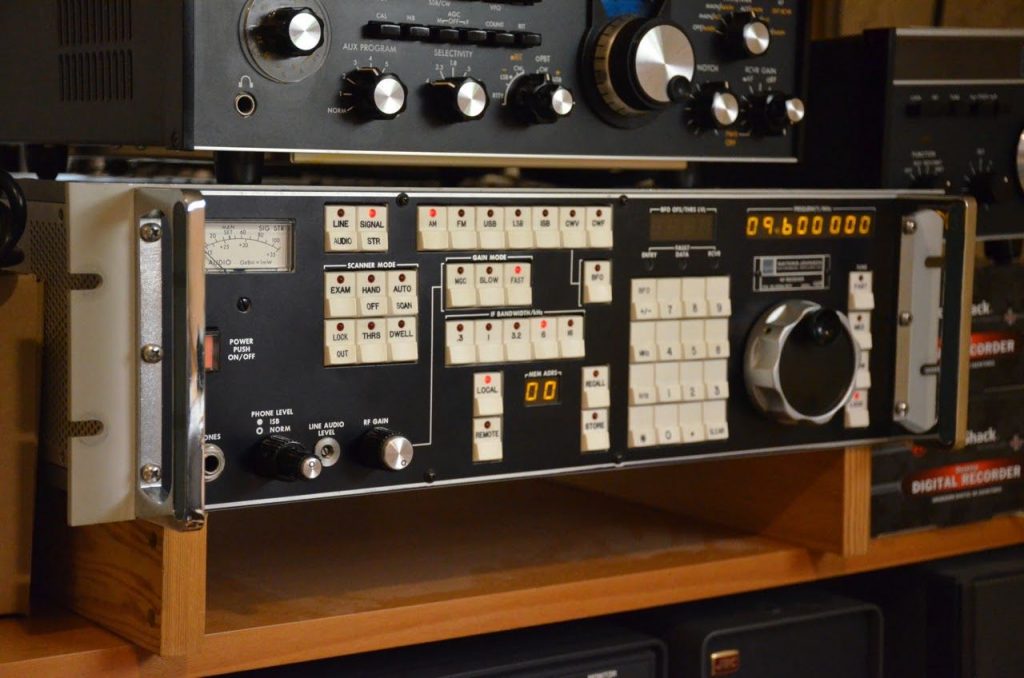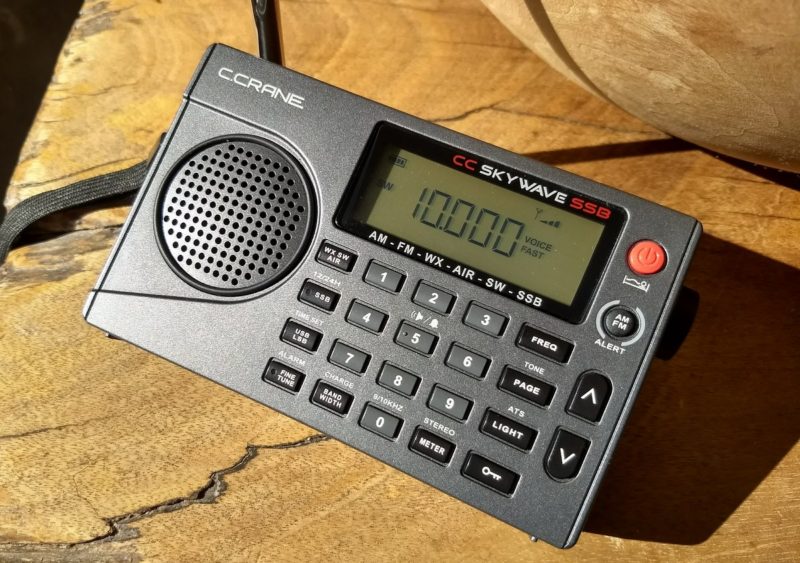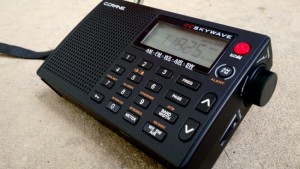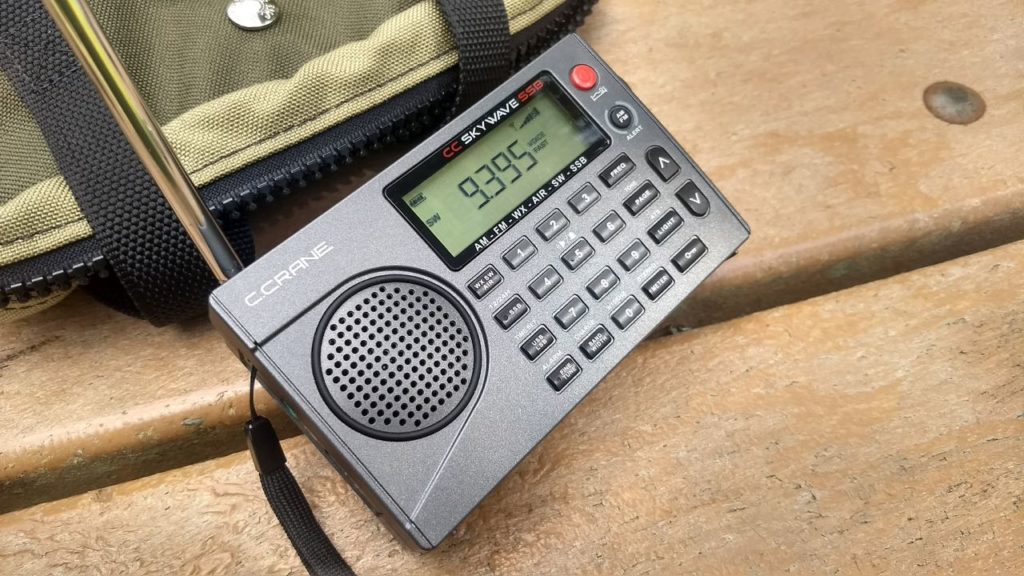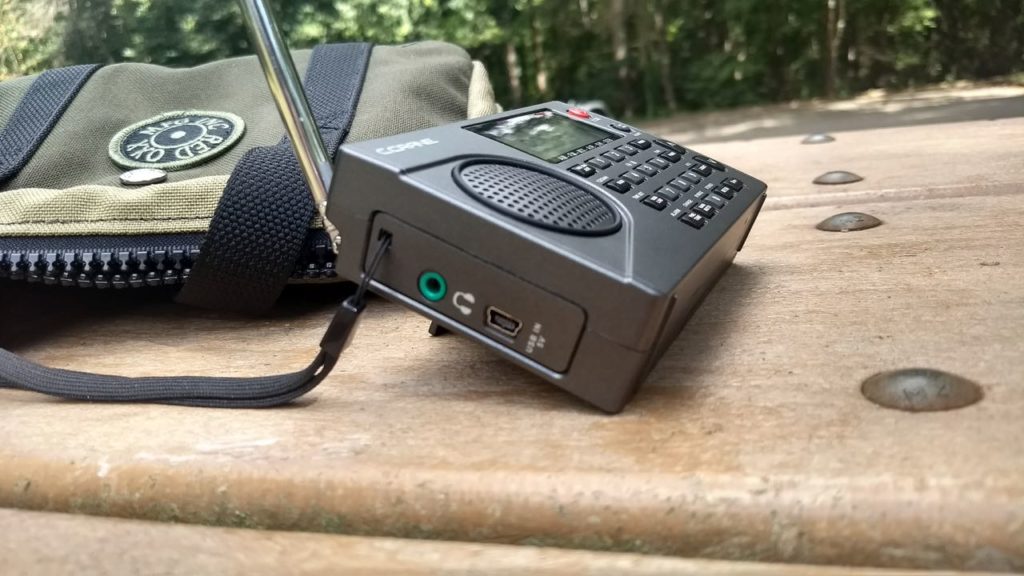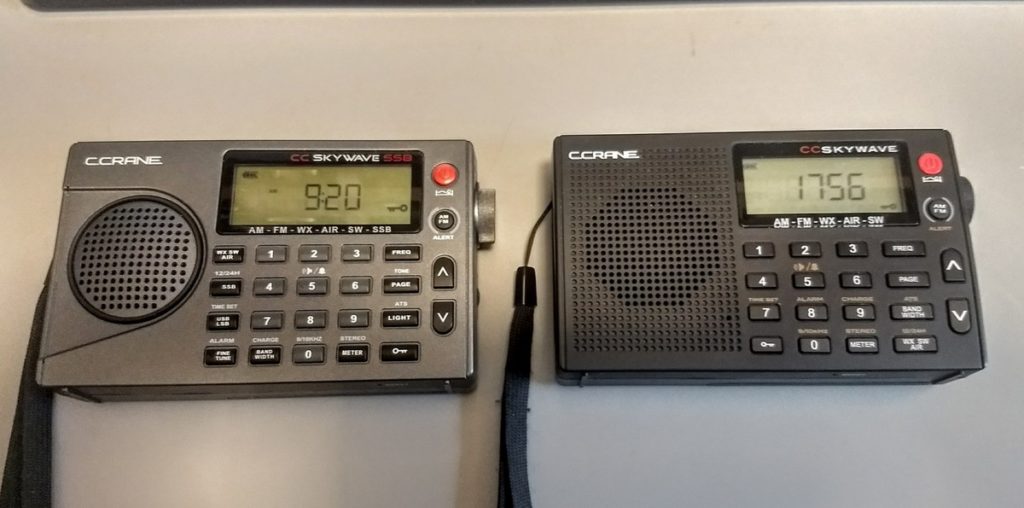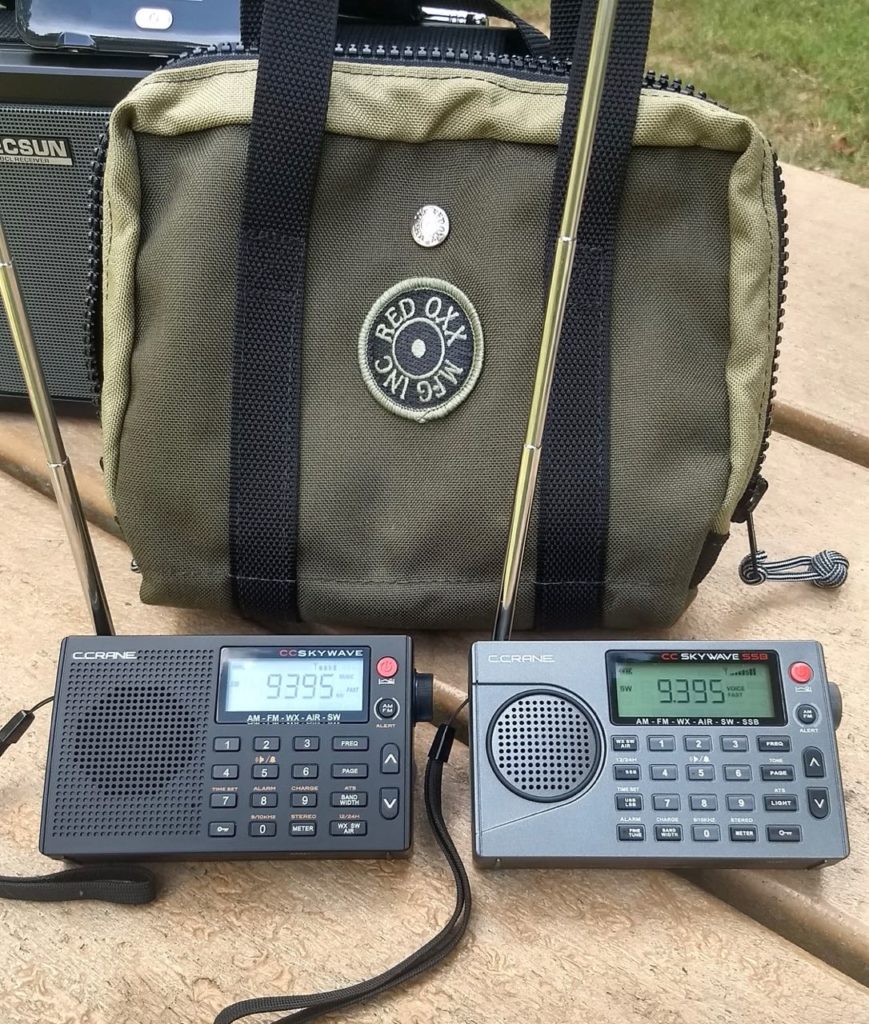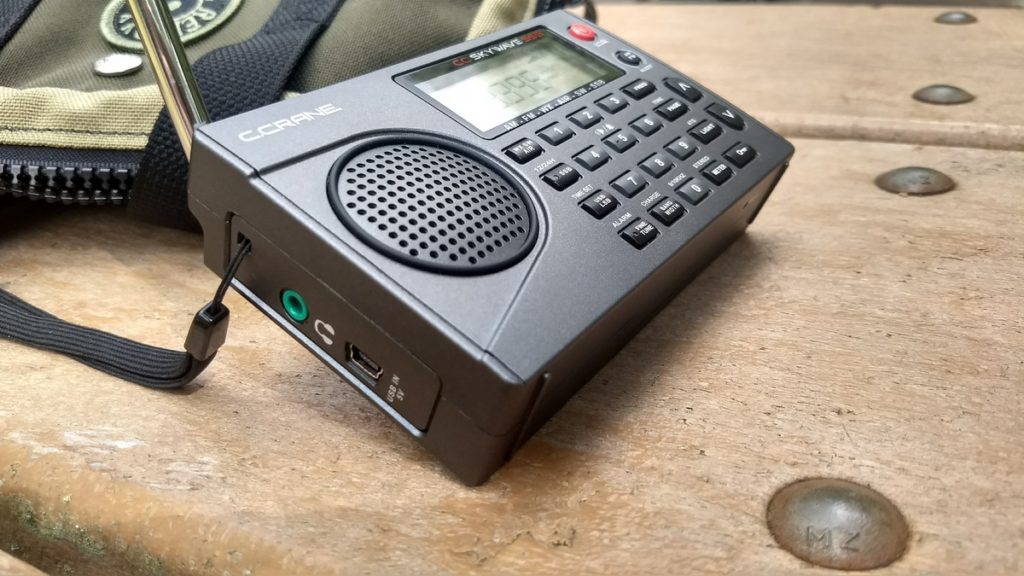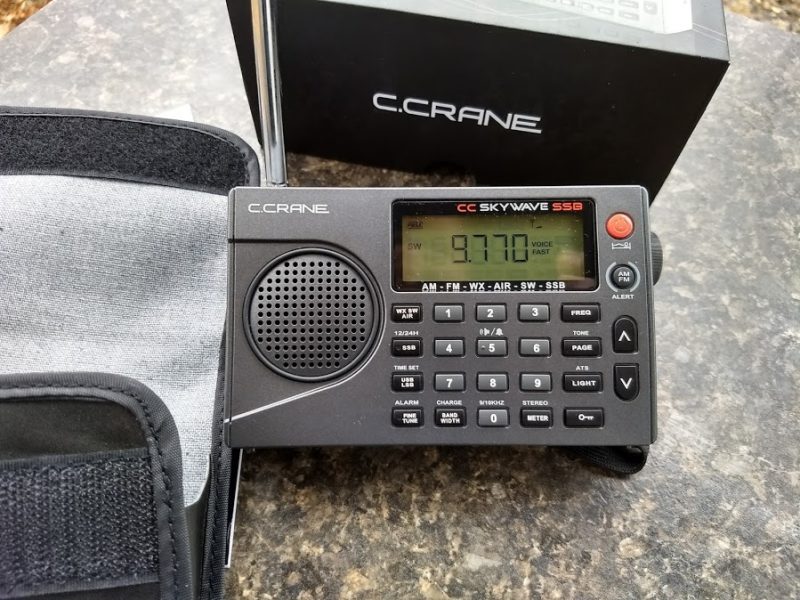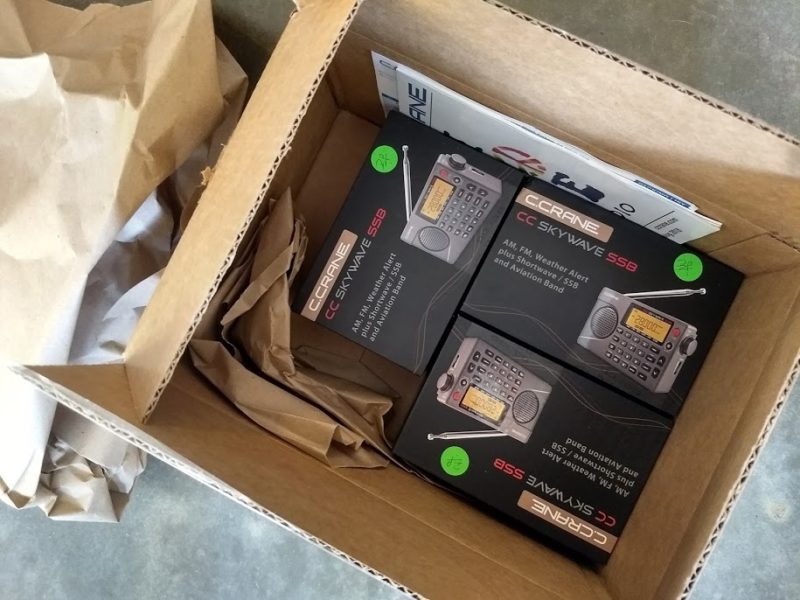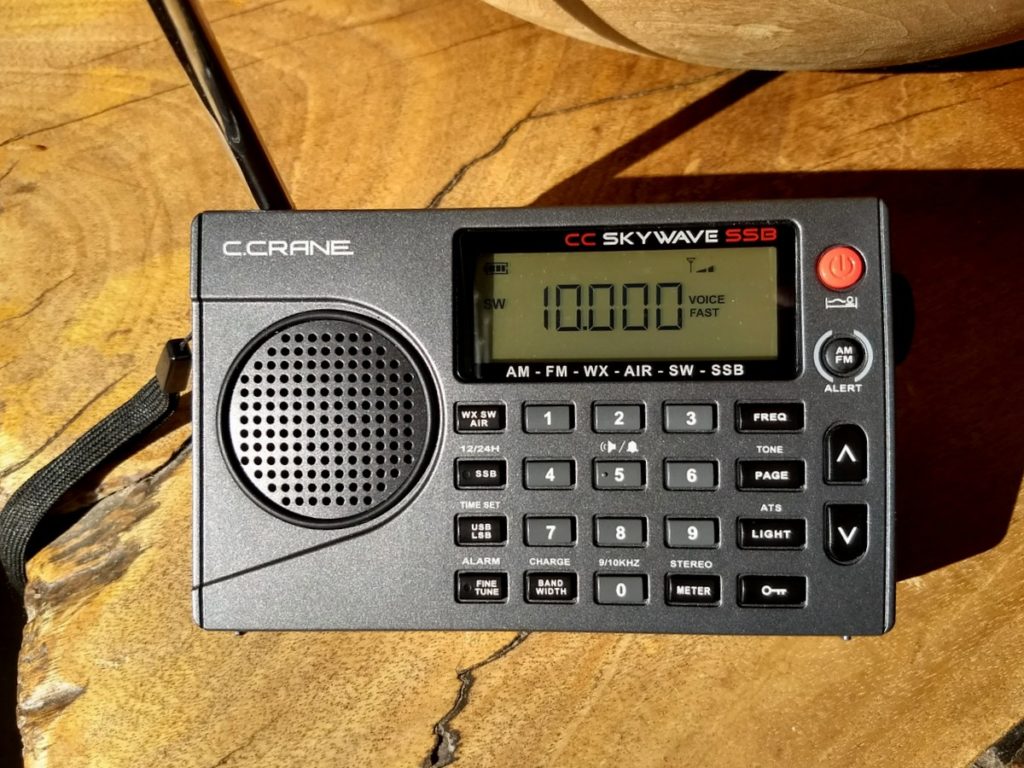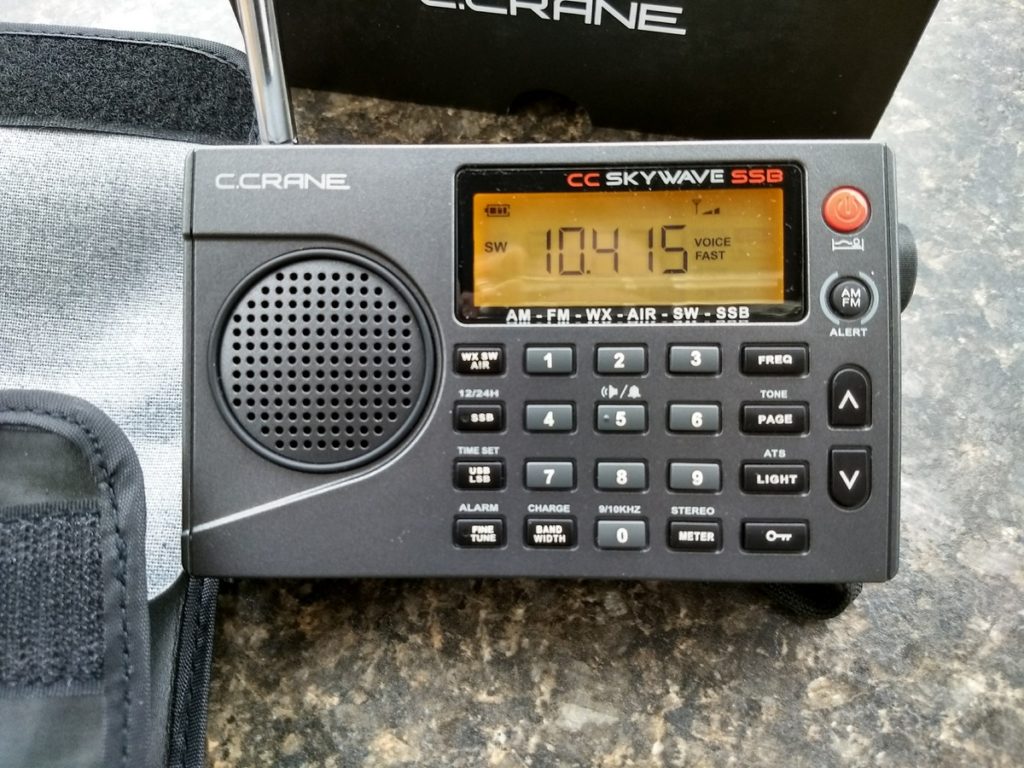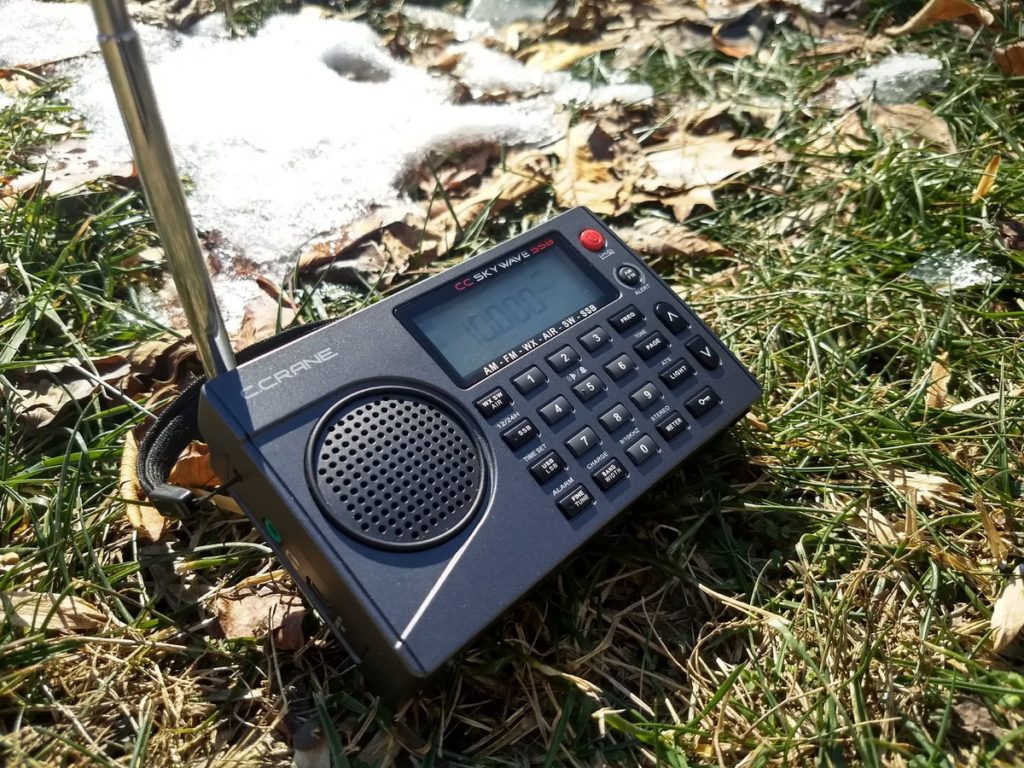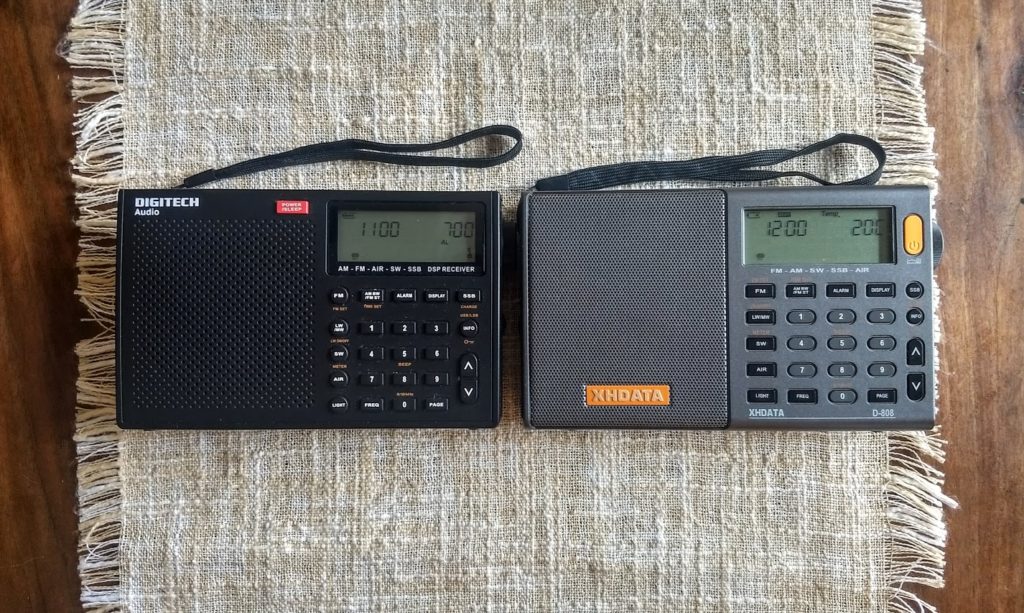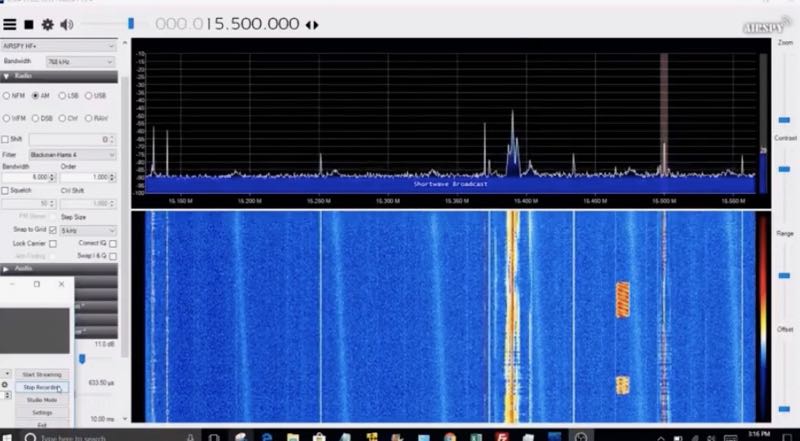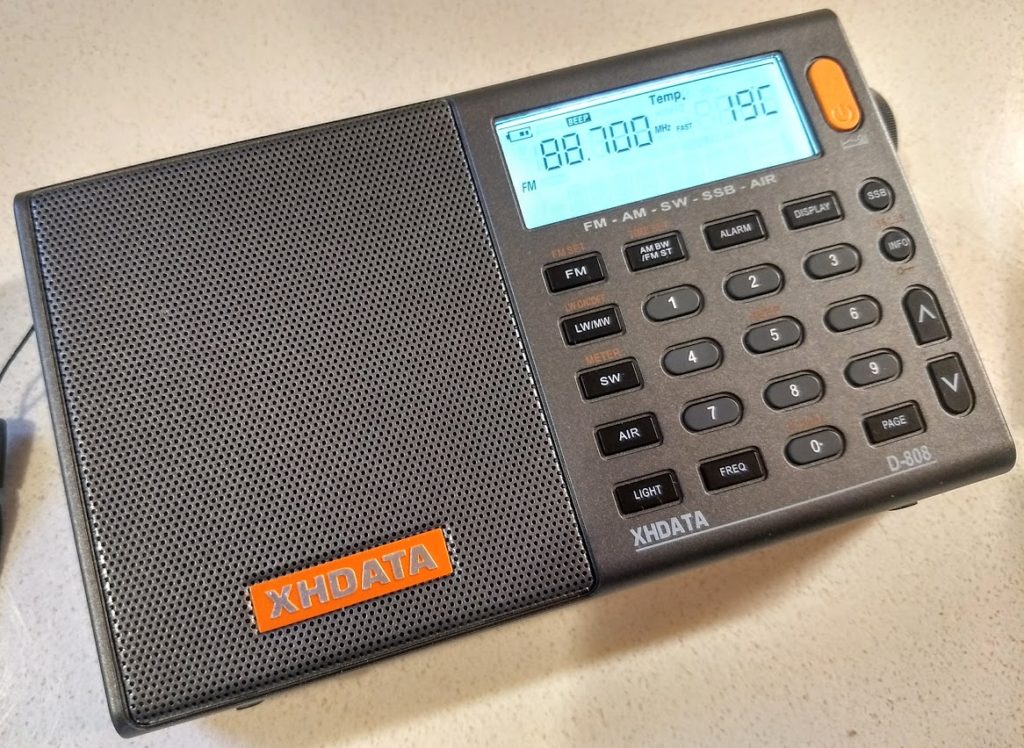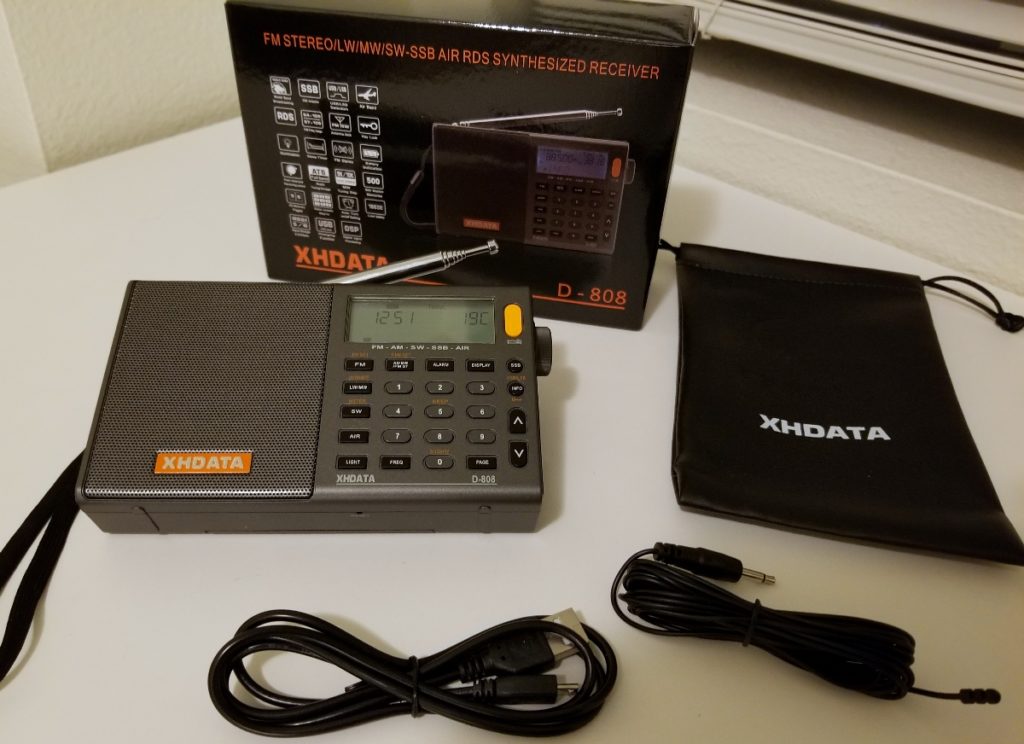Many thanks to SWLing Post contributor, Ivan Cholakov, who shares the following video where he compares the SDRplay RSP1A and the AirSpy HF+ software defined radios on shortwave and mediumwave:
Category Archives: Shortwave Radio Reviews
Guest Post: A review of the Icom IC-R8600 wideband SDR receiver
Many thanks to SWLing Post contributor, Dan Robinson, who shares the following guest post:
ICOM’s IC-R8600: Can this mega-radio stay in the ring with big gun “legacy” receivers when it comes to shortwave band reception?
by Dan Robinson
When ICOM rolled out its new wideband receiver, the IC-R8600, I immediately took an interest in it. I have been primarily a hardcore DX’er and SWL and avoided purchasing wideband receivers, including the predecessor IC-R8500, because they were limited in areas such as selectivity.
My experience with ICOM includes owning a IC-R71A and R72, both of which I found to be strong performers, as well as a IC-R75. The R75 as everyone knows established a reputation as an excellent receiver that delivered bang for the buck, including for example 1hz readout and extreme stability.
In its design decisions with the 8600, ICOM clearly intended to hit it out of the park, taking a huge step from the 8500. That can be seen in the amazing color 4.3 inch LCD display with fairly fast spectrum scope and waterfall displays, coverage from 10 kHz to 3 gHz, decoding capability in multiple protocols, (Baudot RTTY, D-STAR™, NXDN™, dPMR™, DCR (Digital Communication Radio) and APCO P25, and the combination of SDR and superheterodyne circuitry, with 2000 memories.
At this point, there have been numerous reviews of the 8600, and videos are all over YouTube showing the basics of its operation and features. It has numerous flexibilities selected from the front panel and within the menu system. The ability to record directly to SDHC cards eliminates the need to attach an external solid state recorder (over the course of my DX career I accumulated many of these). I can’t say enough about this capability which automatically keeps fully labeled logs.
Other features include ICOM’s wonderful Twin Passband Tuning, combined with the ability to adjust filters 1/2/3, adjustable attenuation, Digital AFC, tone controls, noise blanker digital noise reduction, speech enunciator, main tuning dial tension adjustment, synchronous L/U/Double sideband, adjustable panel brightness . . . in short, just about everything one would think should be included in a 21st century receiver of this kind, ICOM put in the 8600. The firmware update released recently (1.30) added the capability to use the radio’s IQ output with HDSDR software, which means that the receiver is now not only a standalone but also functions easily with a PC.
Since the 8600 has been on the market for some time now, I discussed with Thomas Witherspoon of SWLing Post, the idea of obtaining an 8600 for the specific purpose of comparing it to some of the top receivers in my collection.
At the current time, that list includes a JRC NRD-545, the Drake R-8 (original version purchased in 1993), JRC NRD-515, Watkins Johnson 8718A/MFP, Cubic R-2411, and a McKay Dymek DR-33C. All of the radios in my shack use a Wellbrook 1530 loop, fed through a RF Systems DA-8 Distributor/Amplifier which maintains signal levels from all outputs.
A surprising outcome of my comparisons of the 8600 to these radios is that my appreciation of the qualities of these older receivers was actually re-ignited–so much so that some that had been on my ‘to sell’ list are now back in the ‘keepers’ column. This is not as much a criticism of the 8600, as it is a reaffirmation of the quality that was built in to some of the great receivers of yesteryear.
Because my collection actually extends across 2 or 3 rooms, moving the 8600 away from my central receiver “stack” was not possible, so testing comparisons were limited to the sets mentioned above. I would have liked to compare the 8600 with, for example, some classic tube receivers (HQ-180A, Eddystone 830/7), but they have been mostly inactive and located away from incoming antenna inputs.
Here in Potomac, MD outside of Washington, DC, the addition of the Wellbrook a few years ago, after years suffering with long wires, fundamentally changed a difficult situation. Signals were boosted, noise reduced. I wish things had continued this way. Unfortunately about a year ago, my area began to be plagued by a troubling ignition-type buzz, source unknown, targeting 11,500 to 12,100 khz though noticed elsewhere in the shortwave bands. It has continued, usually worse in summer than in winter.
I begin with this to underscore what I noticed as a high point for the 8600: its Noise Blanker and digital noise reduction are in my opinion quite effective, so much so that when properly adjusted, they can eliminate troublesome ignition-type noise. While NR is useful, as noted in other reviews it needs to be used carefully so as not to introduce too much digital suppression.
Here is an example of NB and NR in use against severe ignition-type noise at my location:
Click here to view on YouTube.
In August of 2017, I had my first experience tuning a 8600 at a DXpedition in Ohio.
So, I had a basic grasp of the various controls — the A/B/C knobs, and the menu system. When I received my review unit from ICOM last November, I was up and running quickly, but still puzzled over some aspects of the receiver’s operation.
Thanks to Dave Zantow who alerted me to a possible issue involving firmware 1.30 which appeared to introduce an increase in audio harshness (ICOM has been alerted to this). Dave also had suggestions (see his full review of the 8600 and other receivers on his site) about audio adjustment and speakers, and tweaking of the front display to make maximum use of the Peak and Waterfall settings. Dave emphasizes that careful adjustment is required of the 8600’s tone controls and AGC decay settings to get the most out of the receiver.
Because it is among the receivers in my shack in close proximity to the 8600, I chose to perform a number of tests comparing the ICOM to the Japan Radio Company NRD-545. As everyone knows, the 545 was the last in JRC’s prosumer line of receivers. It is feature-rich — JRC threw everything into this receiver. But one issue followed JRC receivers through the 5xxxx series — noisy audio. After finally acquiring a 545 some years ago (a high serial number unit formerly owned by the late Don Jensen) I jumped on that bandwagon of criticisms about the 545’s audio. However, in terms of sensitivity and numerous tools to hear and process signals, the receiver remains among my favorites, and this remains the case after my comparisons with the 8600.
When I compared signals heard by the 8600 with the 545, I found that while the JRC does have that ‘DSP’ sound, it was in many situations actually clearer than the ICOM. That was the case even when following advice on adjusting the 8600’s tone controls and AGC. The following two videos compare the 545 and 8600 on 5,905 khz and 17,655 khz. A third shows the receivers on 6,040 khz demonstrating effectiveness of their notch filtering capabilities:
ICOM IC-R8600 v NRD-545 on 5,905 kHz
Click here to view on YouTube.
ICOM IC-R8600 v NRD-545 on 17,655 kHz
Click here to view on YouTube.
ICOM IC-R8600 v NRD-545 notch on 6,040 kHz
Click here to view on YouTube.
My next comparison was the Drake R8. Little can be said about the Drake R8xxxx series of receivers that hasn’t been said. That superb Drake audio, established with the R8 and continued through the R8B, puts these receivers at the top of the heap and makes stations stand out. So, it’s little surprise then when compared to the 8600, which is an SDR in the HF range up to 30 mhz or so, the R8 still sounded superior on many, though not all, stations. Use of the SYNC mode (not adjustable on the original R8, but was on the R8A/B) also improves recoverable detail on the Drake.
The following video shows the 8600, 545 and finally the R8 on 5,995 khz (Mali), and the three receivers compared on 9,650 khz (Guinea), and a third comparing the 8600 with the full range of receivers in my main receiver stack, tuned to 9,415 khz which at the time was China Radio International.
Click here to view on YouTube.
Click here to view on YouTube.
Click here to view on YouTube.
Despite what some critics have said, I believe that the 8600’s synchronous detection modes are actually pretty good, helping with fading and stabilizing signals. I think the ICOM’s sync is certainly superior to what I experienced with the IC-R75. I would rate the SYNC on the AOR 7030+ superior to the 8600, with the NRD-545 a bit behind the 8600.
Acquired about 2 years ago, my AOR-7030+ is a late serial number version of this fantastic receiver. If I were to sell every radio in my shack but 5, the 7030 would not leave. Put simply, it is among the top shortwave receivers ever made, with off-the-charts audio, and if one has the rare NB7030 card, amazing notch and other capabilities. Comparing the 7030 to almost any other shortwave receiver ever made is like putting a Ferrari on the track with the competition. The audio, and reception tools are just that good.
At the same time, in the 8600 ICOM has produced a receiver that has as many of the essential tools required to manipulate and clarify signals as exist. The twin passband tuning continues to be superb. Being able to vary bandwidth in conjunction with the PBT, and do so even in SYNC mode, further enhances reception powers. Combine this with the ability to actually see signals on the 8600’s beautiful color LCD — we’re getting pretty close to the ultimate receiver (though I would love for someone to drop the successor to ICOM’s IC-R9500 on my front doorstep).
The following videos compare the 8600 to the same full range of receivers, ending with the Watkins Johnson 8718A/MFP, all tuned to 5,935 khz, followed by a comparison of receivers tuned to 5,000 khz
Click here to view on YouTube.
Click here to view on YouTube.
In the following videos, I compare the 8600 to other receivers 11,810 khz (BBC) which shows
the superb audio of the Drake R8xxxx series, yet the 8600 does quite well, and another video
compares the 8600 with the 545 and R8 tuned to 6,070 khz.
Click here to view on YouTube.
Click here to view on YouTube.
In the months that I have had the 8600, I did some comparisons with other receivers, among them my Watkins Johnson 8718A/MFP, which you saw in several videos. WJs prior to the 8711/HF-1000s were built like boat anchors and are QUIET. WJ, Cubic and similar sets manufactured for government and intelligence agencies, shared superb sensitivity, and most cases, excellent audio.
Comparisons of the 8600 on shortwave frequencies had the so-called Premium radios out front. The ICOM clearly shined when it comes to modern signal processing and adjustment tools such as PBT, Notch, and infinitely variable selectivity.
Summary
So, here’s a summary of my impressions after weeks of testing the ICOM IC-R8600 against some of the top gun receivers of yesteryear.
The 8600 scores a 10 on reception tools that are useful — though not crucial in these days of waning shortwave broadcasting activity — in producing and processing listenable audio: Twin PBT, Notch and Auto-Notch, Variable Bandwidths (though limited at the high end to 10 kHz), Pre-Amp and Attenuation, and that beautiful color LCD that allows one to see signals.
Predictably, the 8600 doesn’t blow away premium receivers that were manufactured to pick up the signal equivalent of butterflies and targeted government and spy agencies, and it also does not out-perform a range of other classic receivers whose reputations are well-established.
From a sensitivity and audio perspective, there is no real competition with the Drake R8, which time and time again excels in producing superior easy-to-listen audio. And the same holds for the AOR 7030+.
JRC’s NRD-515 more than holds its own and in many cases exceeds the 8600 in signal sensitivity, and producing listenable audio, despite its selectivity limitations.
The NRD-545 — maligned by critics for its DSP audio, often produced highly-listenable audio even in comparison with the 8600. The ICOM and the 545 share features that provide tremendous flexibility, the tools required to slice and dice signals. If the JRC NRDxxx receivers were the modern equivalent of such boat anchor classics as the Hammarlund HQ-180A, the 8600 is certainly at the top of the heap when it comes to having those same tools in a 21st century receiver.
Audio Samples
I performed some additional audio only tests between the 8600 and NRD-545 on several frequencies. In each, I carouseled from wide to narrow on the 8600, and did the same on the NRD-545. Here are the results:
9,445 kHz
9,420 kHz
11,735 kHz
11,810 kHz
11,945 kHz
15,580 kHz
6,070 kHz
9,650 kHz
11,900 kHz
You may have noticed that while on some examples the 8600 appears to sound better, the 545, with DSP technology born in the 1990’s is more than competitive with the ICOM.
Conclusion
In conclusion, with the 8600 we have a receiver that tunes up to 3 gHz, with highly flexible color scope, usable with HDSDR, with every tool imaginable for sifting through signals from 10 kHz up to 30 MHz, which is the area I have focused on for decades.
ICOM’s superb Twin PBT knocks out interference and narrows the heck out of any signal, with highly adjustable notch capabilities, customizable bandwidth functions, and what I consider to be highly effective noise blanking and noise reduction. Add to this 2,000 memory channels, multiple antenna inputs, adjustable attenuation and AGC and you have far more than what is needed given the current state of shortwave broadcasting.
Here’s the tough question: Would I recommend that a shortwave listener focused on what remains of listening in the SW bands purchase a 8600? Or to put it another way: Is the 8600 that much of a better radio in the SW spectrum? The answer has to be no.
Numerous receivers from the classics to even the latest portables with multiple selectivity flexibility (see the XHDATA D-808 or Eton Satellit) work for that. The used market overflows with superb HF communications receivers. Any of the Drake R8xxx series receivers, available on the used market for $400 to $1,000, now constitute overkill when it comes to reception in the MW to 30 mHz range.
But if you can project someday to having the time and patience to apply yourself to what is available above 30 MHz, and have the appropriate antenna(s) for those ranges, then by all means, the 8600 is the radio for you. It is the Babe Ruth’s bat of the receiver world — AND it has numerous flexible tools (though one wishes that ICOM had included DRM capability).
As I finalized this review, I continued to wrestle with the decision of purchasing the 8600 that was so generously provided by ICOM. You won’t read here what my final decision was–but anyone who is interested can contact me in coming days and weeks to learn the answer.
Last minute update Just before this review went to press, I discovered an issue of concern: when the 8600 was left on overnight, or for any period of multiple hours, upon awakening from “sleep” (screen off) mode, nothing but distortion is heard from the speaker. The only solution was to perform a POWER OFF/POWER ON, after which normal audio was heard. This issue was I brought to the attention of ICOM.
I want to thank Ray Novak and Faheem Hussain of ICOM for providing the 8600 used in this comparison, and for their patience as I encountered several delays completing my review and getting to print. And thanks to Thomas Witherspoon without whose initial encouragement, this review would not have been possible.
Dan, thank you for an amazing IC-R8600 review and comparison with your benchmark commercial grade receivers! Thanks for taking the time to make thorough comparison video and audio recordings. Your guest posts are always most welcome on the SWLing Post!
A review of the C. Crane CC Skywave SSB ultra compact travel radio
The following review first appeared in the January 2018 issue of The Spectrum Monitor magazine.
[IMPORTANT UPDATE (October 21, 2018): I’m pleased to report that C. Crane have addressed issues that I found in the first production run of the CC Skywave SSB. Click here to read the update.]
Those who know me know I’m all about travel, and all the things that make the travel experience enjoyable. I like to pack light, taking only the essentials, and if I’m traveling by air, I can easily fit two weeks of fun into one small carry-on. To me, the idea of lugging a huge suitcase, being subject to lost check-in luggage, and fretting over finding room in an overhead bin to squeeze in a huge bag simply has no appeal. Even though I often opt for the budget ticket, which means loading later, I know I can literally be the last one on board without fear because my travel bag is so compact that, if nothing else, it will fit underneath the seat in front of me.
Yet even though I travel light, I never ever travel without a radio. That’s a given in my bag. Since packable real estate in my carry-on is at a premium, I opt for the most bang-for-buck I can manage in a portable radio.
My radio travel partners
To date, I have a few favorite full-featured travel radios and know quite well both their strengths and weaknesses. Here’s a list with some notable pros and cons:
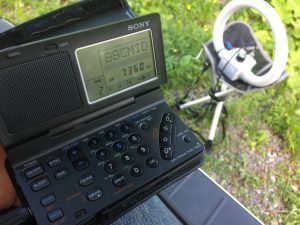 The Sony ICF-SW100
The Sony ICF-SW100
- Pros: A 1990s era marvel of compact technology, it sports SSB mode, sync detection, headphone and audio out jacks, external antenna jack, and long life on two AA batteries. It has excellent sensitivity and selectivity. No muting between frequencies spoils listening pleasure.
- Cons: Speaker audio is poor, no FM RDS, no weather radio, no AIR band, the battery cover may be easily broken, ribbon cable can break (in early models) and the clamshell design, while a cool feature, isn’t always practical and makes the unit feel prone to damage. Plus, the SW100 series is no longer manufactured and, due to desirability, typically have a price point well above the competition.
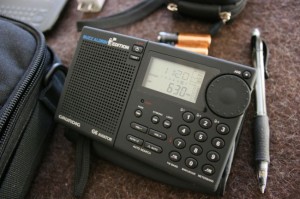 The Grundig G6
The Grundig G6
- Pros: A compact, ergonomic full-featured radio which sports SSB mode, AIR band, external antenna jack, reasonable audio from internal speaker, very good shortwave and mediumwave performance for the size. No muting between frequencies.
- Cons: Rubberized coating becomes sticky as it deteriorates, no weather radio, no audio-out jack, no RDS, and it’s no longer manufactured.
 The Tecsun PL-310ET
The Tecsun PL-310ET
- Pros: Very affordable (typically $40-50 shipped), excellent shortwave, mediumwave and FM reception, external antenna jack, average audio fidelity from built-in speaker, internal battery charging, common 5V mini USB plug, reasonably durable.
- Cons: No SSB mode, no weather radio, no AIR band, no RDS, no dedicated audio-out jack, limited shortwave coverage compared with other portables 2.3 – 21.95 MHz
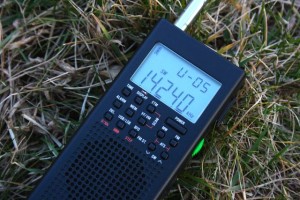 The CountyComm GP5-SSB (a.k.a. Tecsun PL-365)
The CountyComm GP5-SSB (a.k.a. Tecsun PL-365)
- Pros: SSB mode, great shortwave, mediumwave, fm reception, vertical form factor great for handheld listening while walking/hiking, external ferrite bar antenna enables excellent AM/mediumwave reception.
- Cons: Vertical form factor means it’s prone to fall over if placed on a bedside table, no direct entry keypad for frequencies, tinny audio from built-in speaker, no RDS, no AIR band, detachable external ferrite bar antenna is an extra piece to keep up with while traveling.
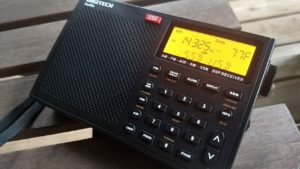 The Digitech AR-1780
The Digitech AR-1780
- Pros: SSB mode, AIR mode, squelch control, FM RDS, dedicated fine-tuning control, external antenna jack, internal speaker provides better audio than other compact travel radios. Excellent sensitivity.
- Cons: Slightly larger form factor than other travel radios. Somewhat awkward ergonomics. 7 VDC power port is non-standard. No dedicated audio out jack.
-
The (original) C. Crane CC Skywave
- Pros: Overall excellent performance on shortwave, mediumwave, and FM. AIR band, North America weather radio (excellent sensitivity) with alerts, squelch control, common 5 VDC USB mini power port with charging capability, a great value at $89
- Cons: No SSB mode, no external antenna jack, no RDS,
What radio I decide to pack really depends on the type of trip I’m taking.
If I really want SSB mode to listen to HF pirates, ham radio, or utility stations, I tend to grab the Sony ICF-SW100, the Grundig G6, or more recently, the Digitech AR-1780 [and now the XHDATA D-808].
If I plan to do extended hiking or walking during my trip, I might grab the CountyComm GP5-SSB.
If I only plan to listen to AM/FM/SW broadcasts, and it’s a short trip––or one during which the radio might receive rough treatment––then I might grab the Tecsun PL-310ET. If I leave the PL-310ET in a hotel or drop it, I’m only out about $40. I’ve even been known to simply give one of these to someone, like a kid for example, who shows a fascination in shortwave radio.
If I plan to do off-air audio recordings during my travels, then the Sony ICF-SW100 because it’s the only radio with a dedicated audio-out port. Plus, it’s a great performer.
If I’m travelling by air, however, I almost always choose the CC Skywave: its unique combination of AM/FM/SW coverage, NOAA weather, and AIR band are simply hard to beat. It’s compact, durable, and gets the job done. Plus, the Skywave seems to operate for ages on a set of AA batteries. C. Crane really knocked it out of the ballpark with the CC Skywave.
But there was one glaring omission on the original CC Skywave: Single-sideband (SSB) mode.
Enter the CC Skywave SSB
Earlier this year, I learned about a new radio in development at C. Crane: the CC Skywave SSB. I saw a Beta unit very early on and a few weeks later, knowing how much I appreciate the original Skywave, C. Crane asked me to help test the new Skywave SSB. I was happy to do my bit.
I actually do quite a bit of alpha- and beta-testing for manufacturers. While it’s time-consuming volunteer work, and requires meticulous attention to detail––even seemingly minor details––it gives me an opportunity to have meaningful positive impact on an upcoming product. Manufacturers that actively involve enthusiasts in their testing phase tend to produce better quality. I wish all manufacturers did this (yes, Tecsun, I’m looking squarely at you!).
After the Skywave SSB arrived, I started putting it through its paces. Typically, pilot run units have quirks and glitches buried in non-standard operating procedures. Try as I might, I couldn’t find any on the Skywave SSB. I’ve since learned that C. Crane invests heavily in pre-production testing; I saw their full list of iterative notes, and they were incredibly detailed. Result? No obvious problems. I’ve always believed that while C. Crane doesn’t always produce the most affordable products––nor do they stuff every bell-and-whistle into them––what they do produce is well thought out, user friendly, well documented, and performs at or near the top of its class.
Features
The CC Skywave SSB comes with a surprising amount of features for such a compact radio. Many of these features are also found on the original CC Skywave.
I’ve placed upgraded features in bold:
-
- AM, FM, NOAA Weather band plus Alert, Shortwave (1711-29.999MHz) with SSB mode, and Airband
- Frequency direct entry, plus auto scan and store
- Lighted LCD display
- Selectable fast or fine tuning (on all bands except weather)
- Dedicated fine tuning control, selectable on front panel
- 400 memory presets
- Runs on 2 AA Alkaline batteries (not included)
- (Optional) CC Skywave AC power adapter w/ mini USB plug required for charging NiMH batteries.
- Stereo headphone jack and fold-out back stand
- Clock with 12/24 hour format and alarm
- Rotary volume knob
- Squelch control
- High quality CC Buds Earphones and radio carry case included
- Run Time (on batteries––approximate):
- ± 70 hours (earbuds)
- ± 60 Hours (built-in speaker)
- 10 Aviation Memories can be scanned for activity
You’ll notice there are actually very few obvious upgrades from the original Skywave to the Skywave SSB: just SSB mode, expanded HF coverage (from 1,711 to 29,999 kHz), and dedicated fine tune button/control. I’ve also learned that aviation band scanning is much faster on the newer model than on the original Skywave.
Other than those items, in terms of features, it’s very similar to the original CC Skywave.
Appearance
The original Skywave and Skywave SSB are nearly identical in terms of form factor; overall dimensions are identical (4.8″ W x 3″ H x 1″ D), although the Skywave SSB weighs 1.2 oz more than the original––a difference that’s scarcely detectable.
The tuning knob, volume control, power port, and headphones jack are in the same places on the SSB. The chassis color is different, however; the original Skywave is black, whereas the new Skywave SSB is grey––a dark warm or “dim” grey,” to be accurate.
Where one finds the true difference between the new Skywave SSB and its predecessor is on the front panel. The Skywave SSB has dedicated buttons to enable both SSB mode, select upper or lower sideband, and a fine-tune control. The Skywave also has a dedicated backlight button. This accounts for a total of four additional buttons compared with the original Skywave.
In a rather nice touch, both the SSB and fine tune buttons have tiny red LED indicators to let the user know when they’re engaged.
The CC Skywave SSB also has a redesigned speaker grill which more closely resembles the grill on their CC Pocket radio. Much to my surprise, once I shared detailed photos of the CC Skywave SSB, many of my readers expressed their disappointment with the speaker design. Many claimed it looked “cheap” as compared with the original Skywave and thus felt the chassis might be more subject to breakage. Some even got the impression that the speaker grill was raised in a way that it would lend itself to harm.
Actually, this is not accurate. Though it may appear that the speaker grill is elevated in photos, it’s actually in a recessed portion of the chassis and surrounded by an absorbent rubber ring, rising only ? 1 mm above the chassis, if that. And the hard plastic case feels as solid and robust as any portable I’ve tested. I wouldn’t hesitate to toss it in my pack.
Personally, I think the Skywave SSB is a handsome little radio! Perhaps I’m not as sensitive as others about chassis design, but I’m actually happy it’s not a clone of the original Skywave, making it much easier for owners of both models to distinguish them when packing!
From Pilot/Beta to production
While C. Crane allowed me to post a number of photos once the product announcement had been made, I would not publicly comment on performance. Indeed, I never post performance comments about pre-production units since I wouldn’t be evaluating the same product that hits the store shelves.
So once C. Crane posted an ordering page for the Skywave SSB, I placed an order, just like everyone else.
In truth, I was told there were only minor differences between the pilot unit and the production unit: some silk screening and other very minor changes.
Production Quirks
[IMPORTANT UPDATE: Again, please note that the following production quirks have been addressed in the second production run of the CC Skywave SSB. Click here to review the update.]
I was eager to get started on the review of the Skywave SSB, so as soon as I received it, I did what I always do: compared it with other radios!
I make my comparisons, by the way, at least fifty yards from my house to separate the radios from any inadvertent sources of local noise.
Production Radio #1
My first comparison was with the Digitech AR-1780 and the original CC Skywave. I quickly noted that the Skywave SSB was very slightly less sensitive than the other radios. I had tested the pre-production unit enough to know that the Skywave SSB’s performance should at least be on par with, if not a little better than, the original Skywave.
Upon careful listening, I discovered the production unit had a faint, internally-generated whine on some of the shortwave bands; when tuned to marginal signals, this whine manifested in the form of variable background noise. Between signals it was audible as a faint background whine, hardly noticeable. With that said, the whine was most notable while tuning––since the Skywave SSB mutes between frequency changes, the whine was most conspicuous during audio recovery between steps.
The pre-production unit had no trace of an internally-generated whine. Audio was very clean in comparison.
Here’s a sample of the first production radio being tuned down from 10,000 kHz in 5 kHz tuning steps:
Here’s a sample from the pre-production unit dong the same:
Hear the whine in the first sample? Yes, so do I.
I contacted C. Crane promptly, and to their credit, they immediately dispatched another unit from inventory, via UPS Next Day, along with a return label to send my faulty unit back to their engineering team.
Production Radio #2
The second unit arrived while I was on Thanksgiving vacation, but was sent to me directly at my hotel. The day I received the replacement Skywave SSB, I put it on the air. The first listening session with it, alone, revealed that this unit did not have the internally-generated whine, however, this unit had issues with sensitivity. All of my comparison receivers were outperforming this Skywave SSB on the shortwave broadcast bands. When I compared it with the pre-production Skywave SSB unit and the first production unit, the second production unit was about four to five S-units less sensitive…Odd.
I sent both production radios back to C. Crane with detailed notes and sample recordings. Their engineering team confirmed my findings and started looking into the variations in QC and double-checking their inventory to make sure none shipped with these problems.
Production Radio #3
A few days later, I was sent a third production unit. After putting it on the air, I immediately noticed the same faint noise characteristics of my first full production unit, which is to say, the notorious whine.
Once again, I contacted C. Crane. This time, I requested that no less than three radios be sent to me, and that they kindly expedite the request.
Production Radios #4, #5, and #6
I tested all three radios from this final batch of production units. What follows is an assessment of those radios.
First production run noises
I spent two full hours searching for birdies (internally generated noises) and other anomalies on the three CC Skywave SSB production units I received that Monday. Each radio’s noise location varied slightly (within 20-40 kHz).
Birdies
Birdies are a fairly common occurrence among sensitive receivers, and the CC Skywave SSB has about an average number. Fortunately, the birdies I noted are outside the space where I do my broadcast listening:
- 2,305 kHz
- 9,220 kHz
- 11,520 kHz
Background audio whine/tone
All of the production units (save Radio #2) had a very slight audio whine present––either via the internal speaker or headphones––on certain portions of the spectrum.
In the first full production unit I received, I believe this whine may have slightly affected the unit’s overall sensitivity. On the last three production units I received, the whine didn’t seem to have as much of an impact on overall sensitivity.
The whine is still there, however. And occasionally when the unit is tuned to a weak signal within one of these zones, other faint sweeping noises can be detected in the background.
Sometimes it’s even more noticeable when the broadcaster is weak and is located within one of the “whine zones.” Here’s an example of 10 MHz WWV time station comparing the original Skywave with the Skywave SSB. Note that at the time this was recorded we had terrible propagation due to a geo storm, so WWV was very weak, indeed.
Listen for the sweeping tones:
Click here to view on YouTube.
Here are the frequency ranges where I noted the background whine:
- 7,830 – 8335 kHz
- 8,610 – 8,690 kHz (note: very faint)
- 9,770 – 10,415 kHz
- 11,585 – 11810 kHz
Another oddity is a noise I found prevalent on CHU Canada’s 7,850 kHz frequency. I’m guessing it may be due to the presence of a DSP birdie on top of a relatively strong broadcaster.
Here’s a video comparing the original Skywave with one of the production models:
Click here to view on YouTube.
I noted no birdies or noises on the mediumwave band.
I’ve no doubt, C. Crane will tackle these issues and solve them by the time the second production run ships.
In the meantime, I’ve become somewhat of an expert on the CC Skywave SSB, having evaluated a total of seven models and spending more time evaluating them than I have any other portable.
Let’s take a look at what we can expect from the CC Skywave SSB with these first production quirks aside.
Audio
Like its predecessor and many other travel radios (the Digitech AR-1780 and XHDATA D-808 being notable exceptions) the Skywave SSB’s audio from the internal speaker is adequate. It’s just shy of what I would call “tinny” because it does cover the mid-range . For spoken word content in AM and SSB, it does the job quite well. With music, you simply can’t expect any bass notes or room-filling audio. But then again, in a compact radio, my expectations are simply lower. The Digitech AR-1780 and XHDATA D-808 have the best audio of my compact travel radios, but they’re also the largest, so have a slightly bigger speaker.
I did note a minor amount of background hiss present somewhere in the audio amplification chain on the first production run units–most noticeable via headphones.
With the supplied CC Buds, you’ll be a happy camper.
Audio sounds rich via the headphones jack.
Performance
Of course, what we all want to know is how well the CC Skywave SSB performs. In a nutshell (spoiler alert!) it’s very similar to the original Skywave.
I break this down band-by-band below, starting with my favorite band.
Shortwave
Keeping in mind the frustrating experience with quality control, when I received the final three production units, I was very pleased with performance on the shortwave bands. The AGC characteristics are relatively stable, making weak signal listening a pleasant experience. Even though the Skywave SSB lacks a synchronous detector, I found that stability––even with periods of notable selective fading––is impressive.
In the realm of compact travel radios, both my pre-production and (better functioning) production models are strong performers. The Skywave SSB is slightly less sensitive than my larger, full-featured portables like the Tecsun PL-660, PL-680, PL-880, and Grundig Satellit. All of these radios, however, have longer telescoping whip antennas. If I add the gain from the included CC Reel antenna, the Skywave SSB can even hold its own with many of these.
I’ve been very pleased with the original Skywave for broadcast SWLing for a few years now. I’m happy to report that the Skywave SSB offers an incremental improvement over the original Skywave.
FM
Much like other modern DSP portables, FM performance is stellar for such a compact radio. The Skywave SSB was able to receive all of my benchmark FM stations. While audio fidelity from the Skywave SSB’s internal speaker is not a strong point, via headphones you’ll be quite pleased.
AM/Mediumwave
I’ve found the Skywave SSB to be capable mediumwave receiver. Performance characteristics are very similar to the original Skywave and the AGC settings even make MW DXing a pleasant experience. Since the internal ferrite bar isn’t terribly large, better performance can be achieved by coupling the Skywave SSB to an inexpensive loop antenna, like the Grundig AN200 AM Antenna.
Weather radio
Like the original Skywave, the Skywave SSB is an impressively capable weather radio receiver. From my home, I’m able to pick up a marginal NOAA weather radio frequency that most of my other weather radios cannot. The Skywave SSB also includes a handy weather alert feature that will monitor your chosen NOAA/Environment Canada frequency and wake up the receiver if an alert is issued.
Note that the weather alert feature works on a timer and, most importantly, if operating from battery, drains batteries as quickly as if you were monitoring a live station with the squelch open.
AIR band
While I didn’t compare performance with a triple conversion scanner, I’m favorably impressed with AIR band performance. During my tests, I noted no imaging or overloading on the AIR band, a very good thing. Additionally, the Skywave SSB offers improved scanning features for the AIR band, making it easier to monitor ground, tower, and even approach/departure frequencies at larger airports. When employing the squelch feature, you almost get the impression you’re holding a scanner, rather than a shortwave portable, in your hands.
Longwave
Like the original CC Skywave, the SSB does not cover the longwave band. In North America, there is very little to listen to on longwave, so many consumers will never take notice. I’m sure longwave DXers will wish it was a part of the package, however. Admittedly, when I’m traveling in Europe and other parts of the world where there are still stations on longwave, I’ll certainly miss the band.
Comparing to other compact travel radios
Trying to decide if the CC Skywave SSB will have the performance characteristics to displace my other travel portables, I compared it with the radios I mention at the beginning of this article.
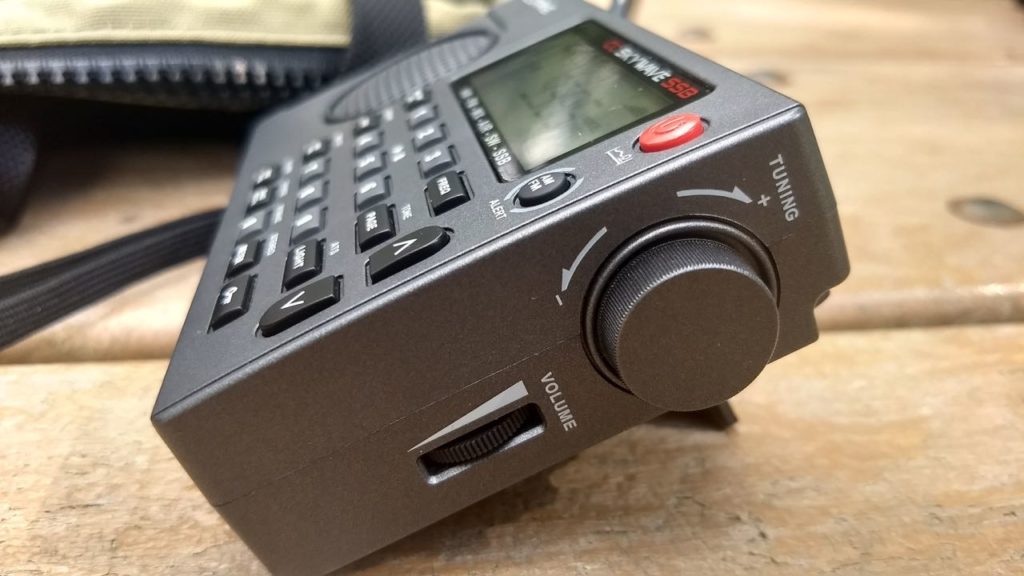 In terms of overall sensitivity and selectivity, the CC Skywave SSB essentially runs neck-and-neck with, or in some respects slightly edges out, the Tecsun PL-310ET, Grundig G6, and CountyComm GP5-SSB.
In terms of overall sensitivity and selectivity, the CC Skywave SSB essentially runs neck-and-neck with, or in some respects slightly edges out, the Tecsun PL-310ET, Grundig G6, and CountyComm GP5-SSB.
However, both the Sony ICF-SW100 and the Digitech AR-1780 are more sensitive than the Skywave SSB. The Digitech AR-1780 has the best audio characteristics of the competitors, but is also slightly larger and heavier than the others.
Note, too, that the Sony ICF-SW100 and Grundig G6 are the only radios in this comparison that don’t mute between frequency changes. They’re the best band-scanning receivers.
And how does the Skywave SSB compare with the original CC Skywave? I find that the Skywave SSB has a slightly lower noise floor which is perhaps helped even further by better audio/tone characteristics. Sensitivity is about the same, but signals pop out of the background static better on the Skywave SSB.
In terms of features, the Skywave SSB likely offers the most for the traveler.
Summary
Every radio has its pros and cons, of course. When I begin a review of a radio, I take notes from the very beginning so that I don’t forget my initial impressions. Following is the list I’ve formed over the time I’ve been evaluating the CC Skywave SSB:
Pros:
- Overall well thought out, considerate design
- Excellent form factor for travel
- Very good sensitivity and selectivity for a compact radio
- Faster AIR scanning compared with the original Skywave
- Better HF frequency coverage than the original Skywave (1.711-29.999 MHz, compared to 2.300-26.100 MHz)
- Pleasant SSB audio
- Multiple bandwidths in both AM and SSB modes
- No overloading noted
- Well-written operation manual
- Excellent weather band reception
- Nice red LED indication lamps for SSB and Fine Tune engagement
- Supplied with:
- a quality external reel antenna
- CC Buds earphones
- Soft case with Velcro closure
- Excellent battery life from two AA cells (AA cells are a plus for travelers as they’re so ubiquitous)
Cons:
- Inconsistent quality from initial production run (update: corrected in second production run)
- Mutes between frequencies while band-scanning
- Engaging SSB mode requires 2-3 seconds of delay (common for this DSP chip)
- Some ticking noise in audio when pressing buttons (identical to the Digitech AR-1780)
- No RDS
- No audio-out jack
- No longwave reception
- ATS Scanning in 1st production run stops at 26,100 kHz
- No synchronous detection (though not expected in this class of compact portable)
- Shortwave ATS tuning time about half as fast as the original Skywave (original is quite speedy!)
$149$169 price is at the top of its class
Conclusion
I love the CC Skywave SSB. Sure, I wish it had RDS, an audio-out jack, didn’t mute between frequencies, and was a little less expensive. But overall, it’s a fantastic package. I’m impressed with the amount of performance the Skywave SSB provides with such a short telescoping antenna.
Most reading this review will be scratching their heads wondering if: a) having SSB mode is worth the $60 premium over the original Skywave ($89 vs. $149)? and b) is any compact radio, for that matter, really worth $149––?
Because of how I travel, I would say that I easily use ultra-compact portables like the Skywave SSB about 70% of the time I’m found listening to portables.
When the Skywave SSB was first placed on the C. Crane website, they posted a price of $169––when the units started shipping, they reduced the cost to $149, and reimbursed those who had placed an order with the higher price. [UPDATE: Early 2018, they once again increased the price to $169.]
Though the initial $169 price made me wince a bit, I still ordered one. Why? Because to me being a traveler who loves an ultra compact, having an ergonomic, full-featured, durable, compact travel radio with SSB, AIR and NOAA weather radio is worth it!
Therefore, the CC Skywave SSB will be my travel radio of choice going forward––it’s essentially a Swiss Army Knife of a travel radio.
There’s another factor, too: I trust C. Crane. Despite the frustrating quirks I experienced reviewing my first production run units, I know C. Crane takes care of their customers in the long run, and will replace any faulty units without hesitation. They’ve taken every item of feedback I’ve provided directly to their engineers and quality-control specialists, and the work continues to resolve this radio’s concerns. If you have a Skywave SSB with noise, don’t hesitate to contact C. Crane about it.
Overall, I am optimistic about this radio. I expect the second production run will produce radios performing as they should––like the final production units I tested, but without the internally-generated noises. [Click here to read second production run update.] And if this occurs as I expect, you can expect good performers.
At any rate, I know this: I’ll be one of the first to test units of their second production run…and to let you know just what I find. (Bookmark the tag CC Skywave SSB for updates.)
Comparing the XHDATA D-808, Digitech AR-1780 and Tecun PL-660 on shortwave
On Friday, I managed to set aside an hour to finally do a video comparison of the Digitech AR-1780 and the new XHDATA D-808.
I placed a table in my driveway, far away from any source of RFI, and set up the radios in identical configurations: same orientation, antennas fully-extended, same AM bandwidth (4.0 kHz), same audio levels, etc. For good measure, I also included the venerable Tecsun PL-660 in the mix.
This was still daytime listening, so all of the stations were from 31 meters and up.
Apologies in advance: somehow the cord from my monitoring headphones is in the shot on some of these videos! I’m still getting used to the new Zoom Q2n video camera:
WRMI 9,455 kHz
Click here to view on YouTube.
WWV 15 MHz
Click here to view on YouTube.
Deutsche Welle 15,200 kHz
Click here to view on YouTube.
Afia Darfur 9,825 kHz
Click here to view on YouTube.
I should add that QSB was slow and deep on Friday. Twice I had to re-shoot videos because the station simply faded into oblivion.
I plan to do a few more comparisons with the XHDATA D-808 and Digitech AR-1780 soon as I’m very curious how SSB reception may differ.
Please comment with your observations. Which radio did you prefer? I’ll hold my comments for now.
Ivan compares the AirSpy HF+ to the KiwiSDR
Many thanks to SWLing Post contributor, Ivan (NO2CW), who writes:
I have been running a public Kiwisdr server for a while and yesterday decided to plug in the new Airspy HF + into the same antenna for a side to side comparison. The antenna is an 80m dipole and the test was done during local afternoon, around 3 PM. I did not use any of the many new noise reduction features that are incorporated into both SDR Console 3 and the SDR web server. The 11 minute video is located here:
Click here to view on YouTube.
When I have the time I will run a similar test in nighttime conditions and also test the Airspy HF+ against a few other radios sitting on my desk.
Thank you for sharing this, Ivan!
Georges’ review of the XHDATA D-808
Many thanks to SWLing Post contributor, Georges (F6DFZ), who writes:
After the first information from your wonderful website, I immediately ordered the XHDATA D-808 receiver from Aliexpress for €62 including shipment to France.
I got it very quickly, shipped from Amazon UK!
I did a few tests on SSB. MDS is outstanding, the minimum signal from my HP generator at -127 dBm (0,1uV), is strong even on 28 MHz. Selectivity is also good, and the opposite sideband rejection is audibly also good. However I was unable to measure it because the S meter give the same indication over a few kHz around the signal of the generator. I suspect the opposite sideband rejection to be done by the DSP chip at AF, but I cannot confirm this.
Reception is very good on FM, and the AF from the loudspeaker is reasonable. On headphones, it’s very good. RDS works as it should and sets the clock of the receiver.
I did only a few minutes test on LW and MW, and it seemed OK, even if I don’t have a lot of experience on these bands.
SW AM listening was very good; good audio, great selectivity. I suspect that the bandwidths given are AF bandwidths as even the most selective were not too much muffled. If it was IF selectivity, the AF bandwidths would have been half the values and much muffled.
SSB and CW reception are also very good even if the DSP chip has a long attack time and hence gives distortion during the beginning of each message.
About SSB: I think that this receiver is better than the [Tecsun] PL-880 and comparable to the PL-660.
Reception is good on the short but sturdy telescopic antenna.
If you connect the receiver to a large external antenna, you will encounter many IMD signals. As there is no built-in attenuator, you will need an external one.
The manual is correct, but very short about the memories.
ATS logs its findings into the first pages, so if you want to keep some memories, log them a few pages away.
The available pages are different with bands, FM has its pages, SW its pages etc…
Unfortunately, memories don’t keep the mode on SW–only the frequency and selectivity. After calling a memory, you will have to choose between AM, USB and LSB.
I was totally unable to light the “Preset” label on the display ?!?
Display and backlighting are very nice.
Somewhat odd, but the squelch seems to work sometimes on other bands than Air band !
Ergonomics are reasonable, quality of construction is good for the price.
Overall, for the price, this receiver is quite outstanding.
Best regards from France .
Georges F6DFZ
Thank you, Georges! Excellent thoughts on the D-808. Your note about squelch control working outside the AIR band reflects what the Digitech AR-1780 does as well–hinting that firmware is very similar.
I fully suspect the D-808 is on the path to being one of the best radio values under $100 US.
Merci bien, Georges!
Short Videos: the XHDATA D-808 Portable SSB Receiver on MW and SW
I recently received a new XHDATA D-808 SSB portable receiver, after AliExpress had a $69 USD introductory sale. I’m intrigued by this new model, as it uses the SiLabs Si4735 DSP chip, the same “brains” that powers the Eton Satellit (and Executive version), and C. Crane Skywave SSB. I believe the same Si4735 is found in Tecsun’s PL-880 and the CountyComm GP-5/SSB. A key feature found in all of these radios is USB/LSB modes and 10-Hz tuning step in SSB.
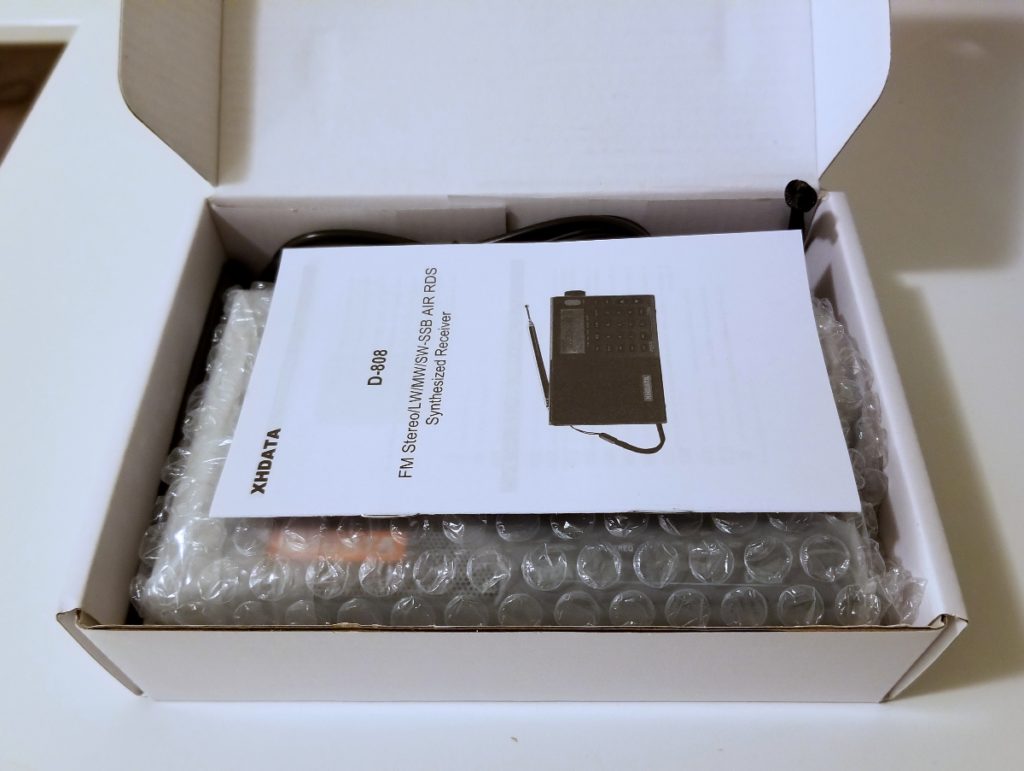
It would be a mistake to assume that all portable DSP receivers with the same SiLabs chip will perform equally; quite the opposite! They all have reception differences that owners will notice. I certainly noticed differences in sensitivity, AGC action, audio quality, and (to some extent) variations in adjacent channel (splatter) rejection between receivers using the same bandwidth. I made these observations when I owned the PL-880 and GP-5/SSB radios. Differences in the circuitry surrounding the SiLabs chip, as well the sizes of MW ferrite loopstick antennas and SW/FM whip antennas contribute to each receiver’s personality.
Below are four videos showing the D-808’s reception of three weaker daytime medium wave stations from indoors at my suburban Seattle-Tacoma (WA) home, plus one video of a shortwave reception in the 41 meter band. The XHDATA D-808 is compared to C. Crane’s newest Skywave radio, the SSB model, and the Eton Executive Satellit. Although brief, these tests show how the new XHDATA portable is a welcome competitor to the field of modern, compact SSB-capable radios:
https://youtu.be/Ef0n5i2UNbo
https://youtu.be/UL6akqUbYMw
https://youtu.be/p41L-ena5rg
https://youtu.be/Wrt6WQ54BTo
What about single sideband? These four videos show reception in AM mode only, but rest assured the D-808 is very capable on the SSB modes of LSB and USB! A separate fine tuning rotary wheel on the right side of the radio’s case offers adjustment in 10 Hertz increments. The effect feels very similar to tuning CountyComm’s GP-5/SSB “walkie-talkie” style receiver. The plus or minus (+/-) offset is displayed in multiples of 10 Hz steps as “-1”, “-2”, “-3”, and so on.
I hope to post some future videos showing SSB usage of the D-808.
Soft mute. The dreaded soft mute is present in AM and SSB mode to some degree, but I do not feel it is excessive. Like most radio hobbyists I’m not a fan of soft muting and prefer uninterrupted tuning with no sign of “chuffing” or lowering of noise or audio. The amount of soft mute on this radio seems the same as the Eton Executive Satellit in my opinion.
What else to like? My take–
Audio. I find the D-808’s audio quality to be slightly more mellow or warmer…I like that, especially on FM! Audio on the MW and SW bands still has a crispness that aids in DXing on those bands, however.
18650 Li-Ion battery. Not all may agree, but I like this style of battery. The D-808’s internal circuit shuts off when the battery is fully charged, or after 10 hours of charging. The radio comes with a 18650 battery and a USB cable; the owner supplies a common 5V USB charger.
RDS on FM. This is a feature lacking on the Skywave SSB, but it is present and performs as expected with the D-808. The XHDATA radio lacks the Skywave SSB’s NOAA weather presets, however.
AM filter bandwidths. Interestingly, this receiver supplies two additional narrow AM mode bandwidths lacking in the Executive Satellit: 1.8 kHz and 1.0 kHz. It’s good to have options, although such narrow filters in AM mode sound a little muffled (offset tuning helps). The Skywave SSB does offer 1.0 kHz in AM mode, but has a 2.0 bandwidth in place of 1.8 kHz.
Backlighting. If desired, the D-808’s easy-on-the-eyes white backlight for the display can remain illuminated continually. Bravo, XHDATA! Now, if we could persuade more manufacturers to add backlighting to the keys themselves (a la the Degen DE1103/Kaito KA1103/Eton E5), we’d have more choices use in low light conditions like camping or bedside use.
Handy size. Probably a third larger than the diminutive Skywave SSB, the D-808 is still a very handy size that will fit most coat pockets, and is a smaller receiver than the Eton Executive Satellit. As you can tell from my videos, reception doesn’t suffer due to the smaller size.
Design. OK, this one’s very personal! As a graphic designer I have a real soft spot for any receiver that looks as good as it sounds, no matter what the technology or vintage. The D-808’s look really appeals to me and adds to my enjoyment while operating it. There are no unnecessary protrusions, ridges, or visual do-dads on this XHDATA model. In fact, I seem some design clues from the stylish Tecsun PL-880 in the D-808. The radio also has a quality feel to the plastic case and buttons, giving it a more “upper class” impression during use.
Antenna jack. The D-808 has the standard 3.5mm antenna port on the left side of the receiver. This is an addition I appreciate, and wish that C. Crane had included one on their Skywave SSB model. I tried this external antenna jack with an amplified PK Loops’ shortwave antenna and the combination performs excellently.
Minor annoyances
So far, the list is short! As a sacrifice to style, the manufacturer has kept all front panel buttons almost flush with the case. The effect looks great, but they are almost too low and close to the front panel. Those with larger fingers may find operation awkward or frustrating. Also, entering a shortwave frequency with less than five digits (i.e., below 10,000 kHz) requires a trailing push of the Frequency (FREQ) button.
I encourage other new owners of XHDATA’s D-808 to leave their comments below. Where does this portable rate among other radios you may own?
Guy Atkins is a Sr. Graphic Designer for T-Mobile and lives near Seattle, Washington. He’s a regular contributor to the SWLing Post.

